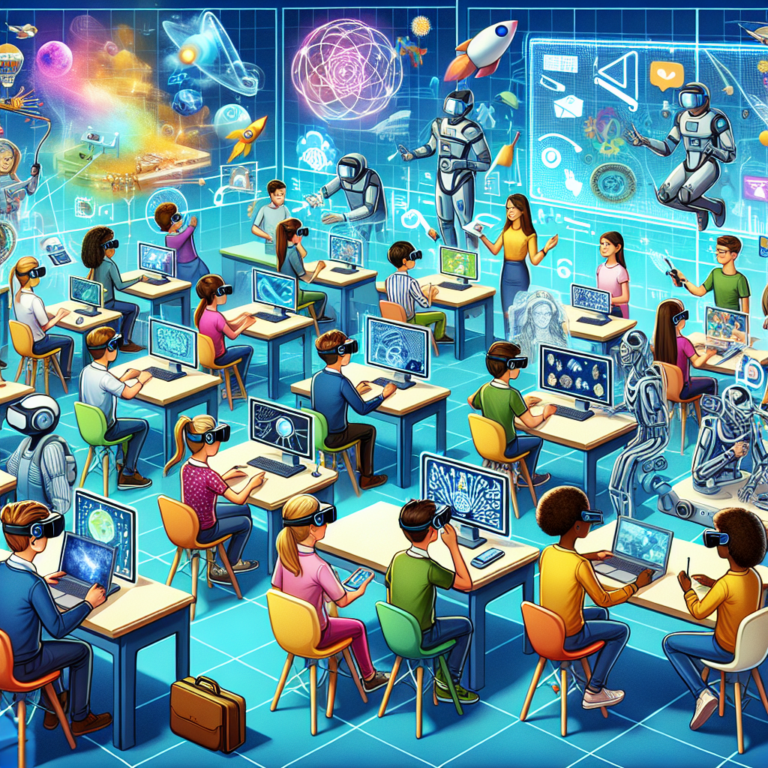0:00
The Future of Learning: Unleashing the Power of Immersive Environments in Education 🌍
What Are Immersive Environments in Education?
Immersive environments in education blend art, technology, and learning to create unique experiences that capture students’ imaginations. These innovative spaces transcend traditional classrooms, fostering deeper engagement and enhancing the overall educational journey. By incorporating technologies like Virtual Reality (VR) and Augmented Reality (AR), educators can bring abstract concepts to life and make learning more relevant and meaningful.
Ether Design Lab: A Trailblazer in Immersive Learning
One prominent player in this transformative landscape is Ether Design Lab, known for integrating cutting-edge immersive technologies into educational settings. Their offerings range from immersive experiences to museum-style collaborative spaces. Students are not just passive recipients of information; they become active participants in their learning processes.
- Group instruction rooms
- Projection domes
- Animations and renderings
- Ongoing technological research and development
By engaging students in a stimulating environment, Ether Design Lab significantly improves attendance and performance. Research has shown that immersive virtual reality (I-VR) leads to enhanced learning outcomes, particularly in STEM fields. Students who experience concepts through VR often exhibit better retention and understanding compared to traditional methods.
The Advantages of Immersive Learning
The benefits of incorporating immersive learning techniques into education are numerous. Whether through gamified e-learning, digital platforms, or immersive experiences, the impact on student engagement and motivation is profound.
1. Enhanced Engagement and Motivation
Immersive learning environments make education exciting. By utilizing interactive and dynamic experiences, students are more likely to remain focused and interested in their studies. This is particularly important in today’s fast-paced world where distractions are everywhere.
2. Improved Knowledge Retention
Students often struggle to remember what they learn in conventional settings. Through immersive learning, abstract concepts become tangible, significantly improving knowledge retention and recall. This hands-on approach allows learners to create lasting memories.
3. Accessibility and Inclusivity
Immersive technologies offer a way to create personalized learning experiences for students with diverse needs. VR and AR can be tailored to accommodate various learning styles and abilities, ensuring that all students have access to quality education.
4. Practical Skill Development
One of the most exciting aspects of immersive learning is its application in practical skill development. Fields like medicine, engineering, and vocational training benefit immensely from realistic simulations, enabling students to practice and hone their skills in a safe and controlled environment.
5. Virtual Field Trips
Imagine students being able to take a virtual field trip to a historical landmark in the morning and conduct a science experiment in a virtual lab by afternoon! Immersive learning breaks geographical barriers, enriching students’ educational experiences by allowing them to explore the world from their classroom.
Challenges in Implementing Immersive Technologies
Despite the incredible benefits, there are hurdles to overcome in adopting immersive environments in education. Nonetheless, the potential for transformative learning experiences outweighs the challenges.
- Cost of Technology: Implementing VR and AR can be expensive, and not all educational institutions have the budget to invest in such technologies.
- Content Development: Creating customized content for immersive learning experiences requires additional expertise and resources currently lacking in some educational settings.
- Adaptability: Some subjects may not easily lend themselves to immersive formats, making it challenging to develop engaging materials for all curricula.
Innovative Projects Showcasing Immersive Learning
The allure of immersive learning has inspired numerous innovative projects. Below are a few standouts that effectively leverage technology for enhanced educational experiences:
- 3D Dissection Tables: These allow students to explore anatomy in-depth, creating a more immersive learning experience.
- Chemistry Apps: Utilize AR to simulate chemical reactions and visualize complex concepts.
- Flight Simulators: Provide aspiring pilots with realistic training scenarios that prepare them for real-world challenges.
- Public Speaking Training: Offer learners a safe space to practice and refine their speaking skills in front of virtual audiences.
- Historical Tours: Enable students to experience history firsthand by virtually visiting significant locations and events.
- Language Learning Apps: Foster immersion in another language through interactive scenarios and real-time practice.
The Future of Immersive Learning in Education
The landscape of education is evolving. The integration of immersive learning technologies offers vast potential for personalization and global connectivity. As we look toward the future, the possibilities seem endless:
1. Personalized Learning Experiences
With VR and AR, students can embark on individual learning paths that cater to their unique needs. This level of customization empowers learners to take control of their education.
2. Global Connectivity
Immersive learning allows students to connect with peers worldwide, breaking down barriers and fostering cross-cultural understanding. Virtual classrooms can accommodate diverse learners, enriching discussions and perspectives.
3. Practical Skill Development
The demand for skills in today’s workforce means education must adapt. Immersive environmental training prepares students for real-world challenges, equipping them with the skills needed to thrive.
4. Enhanced Accessibility
The potential to make education accessible to all is one of the most exciting prospects of immersive learning. By leveling the playing field, every student has the opportunity to succeed, regardless of background or ability.
5. Ethical Considerations
As exciting as this technological evolution is, it also raises important ethical concerns about privacy, data security, and ensuring a safe and healthy learning environment. Tackling these issues head-on will be crucial for the future success of immersive education.
Conclusion
The integration of immersive technologies in education is more than just a trend; it’s a revolution that holds the promise of transforming how students learn and educators teach. With innovators like Ether Design Lab leading the way, education is poised to enter a dynamic new era of infinite possibilities. 🌈




0 Comments